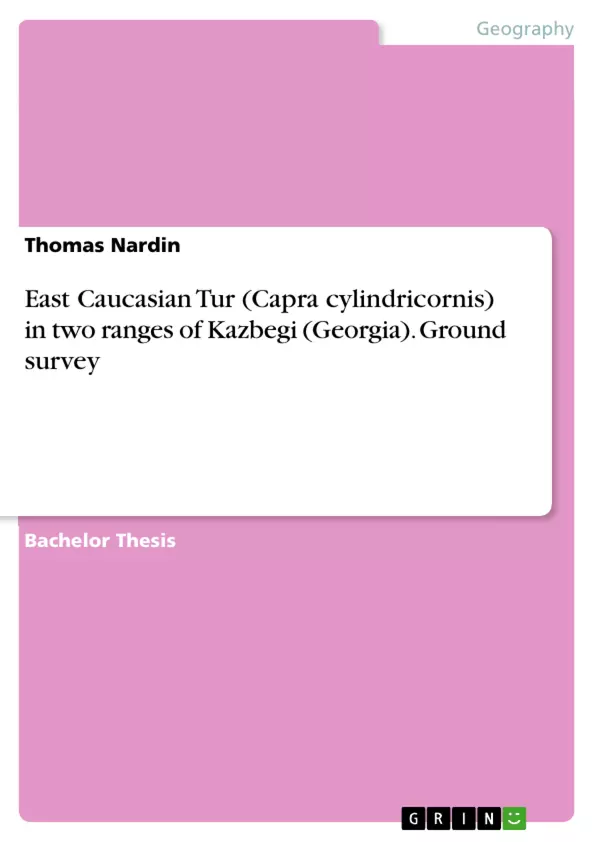The tur is a species of economic interest and concidered a bioindicator. In 2008, tur’s status has improved from ‘vulnerable’ to ‘nearly threatened’ (IUCN4 red-list), nevertheless it remain a species of global conservation concerns. Indeed, the tur habitat is part of a world biodiversity hotspot: the Caucasian region. The loss of quality of its habitat as well as illegal hunting have been identified as threats to the turs population. As a contribution to the monitoring of biodiversity this work aim to design a ground survey method and perform an estimation of turs’ density on two sites situated in the north east district of Georgia known as Kazbegi. The implementation of monitoring of biodiversity is one of the priorities of Georgia’s Ministery of Environment and Natural Ressources Protection.
Inhaltsverzeichnis (Table of Contents)
- Glossary
- Abbreviations
- Table of contents
- Illustrations list
- Aknowlegements
- Abstract
- Key words
- 1 Introduction
- 1.1 Context
- 1.1.1 Legal Basis
- 1.1.2 Biogeography
- 1.2 Objectives
- 1.3 Biology
- 1.3.1 Taxonomy and Phylogeny reconstruction
- 1.3.2 Habitat
- 1.3.3 Diet
- 1.3.4 Activity
- 1.3.5 Social behaviour
- 1.4 Problematic
- 1.5 Status
- 1.1 Context
- 2 Methods
- 2.1 Study area
- 2.2 Sample count protocol
- 2.2.1 Parameters
- 2.2.2 Assumptions
- 2.2.3 Disadvantages
- 2.2.4 Advantages of sample counts
- 2.3 Aerial survey
- 2.4 Material
- 2.5 Questionnaire
- 3 Results
- 3.1 Sampling counts
- 3.1.1 in Kuro range
- 3.1.2 in Chkere gorges
- 3.2 Aerial Survey
- 3.3 Camera traps
- 3.4 Tur Habitat
- 3.4.1 Aspect
- 3.5 Questionnaire
- 3.5.1 Answearing question 1.
- 3.5.2 Movements.
- 3.5.3 Threats
- 3.5.4 Opportunities
- 3.1 Sampling counts
- 4 Discussion
- 4.1 Final word
- 4.2 Opportunities
- 4.3 Protection
- 4.4 In the fu’tur’
- 5 References
- 5.1 Books and scientific articles
- 5.2 Documents not cited in the text
- 5.3 Internet websites and software
- 5.4 Graphic credits
- 6 Appendix
Zielsetzung und Themenschwerpunkte (Objectives and Key Themes)
This bachelor thesis aims to investigate the population dynamics of the East Caucasian Tur (Capra cylindricornis) in the Kazbegi district of Georgia. The study focuses on understanding the species' distribution, abundance, and the threats it faces. The main objectives are to develop a ground survey method to monitor the tur population, estimate the density of the species, and analyze the key drivers of population decline. Through field observations, sample counts, and questionnaire surveys with local actors involved in conservation, the study aims to propose management strategies to ensure the long-term survival of this endangered species. The key themes explored in the thesis include: * **Conservation and management of endangered species:** The study highlights the importance of monitoring and management strategies for the East Caucasian Tur, a species facing numerous threats to its survival. * **Population dynamics:** The research explores factors influencing the tur population's size, distribution, and movements, including habitat selection, predator-prey relationships, and human impact. * **Habitat suitability:** The thesis examines the tur's preferred habitat and how it overlaps with human activities such as livestock grazing and tourism. * **Threats to the species:** The study identifies and analyzes the various threats to the tur population, including illegal hunting, habitat degradation, and climate change. * **Conservation opportunities:** The research proposes potential conservation measures to improve the status of the East Caucasian Tur, such as promoting sustainable hunting practices, establishing protected areas, and implementing translocations.Zusammenfassung der Kapitel (Chapter Summaries)
Chapter 1: Introduction
This chapter sets the context for the study, providing a brief overview of the East Caucasian Tur's legal status, biogeography, and biology. It highlights the species' importance as a bioindicator and emphasizes the conservation challenges it faces. The chapter also presents the objectives of the research, outlining the methods used to address the study's key themes.Chapter 2: Methods
This chapter details the methodology employed in the research, focusing on ground survey techniques. The study utilized sample counts as the primary method for estimating tur abundance, and the chapter outlines the protocols and assumptions associated with this approach. The chapter also describes the aerial survey methodology used to complement the ground survey data. The questionnaire survey conducted with local actors involved in conservation is presented as a way to gather insights into the species' status and management opportunities.Chapter 3: Results
This chapter presents the results of the ground survey, aerial survey, and questionnaire. The chapter summarizes the tur population densities estimated from both the ground and aerial surveys, highlighting the potential differences in estimates depending on the method used. The chapter also analyzes the results from camera trap observations, providing insights into the species' behavior and activity. The results of the questionnaire survey are presented, outlining local perspectives on the threats to the tur population and opportunities for conservation.Chapter 4: Discussion
This chapter discusses the findings of the research, emphasizing the limitations and implications of the results. The chapter compares and contrasts the estimated densities derived from ground and aerial surveys, acknowledging the need for a combined approach to monitor population changes over time. The chapter then explores the potential for translocations as a conservation measure, considering the species' habitat connectivity and human infrastructure impacts. The discussion also examines the challenges of implementing effective protection measures in the context of illegal hunting and lack of enforcement.Schlüsselwörter (Keywords)
The research focuses on the conservation and management of the East Caucasian Tur (Capra cylindricornis) in the Kazbegi district of Georgia. Key concepts include: endangered species, population dynamics, habitat suitability, threats to the species, conservation opportunities, ground survey, sample counts, aerial survey, camera traps, questionnaire survey, bioindicator, illegal hunting, habitat degradation, and translocations.- Quote paper
- Thomas Nardin (Author), 2013, East Caucasian Tur (Capra cylindricornis) in two ranges of Kazbegi (Georgia). Ground survey, Munich, GRIN Verlag, https://www.grin.com/document/1191294



